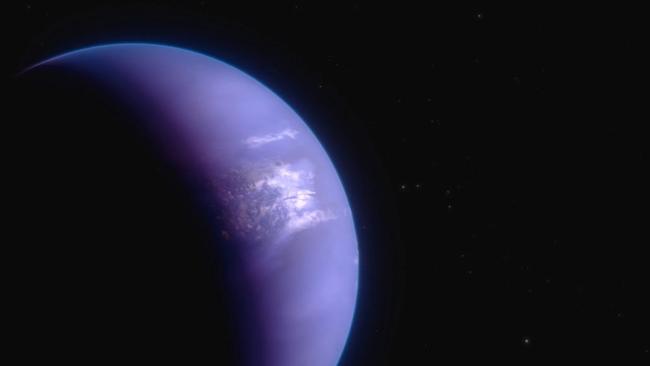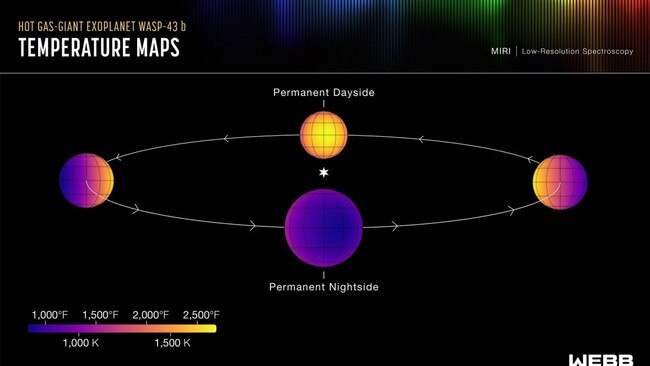NASA forecasts the weather on distant planet
Measurements from a powerful space telescope have allowed astronomers to produce a weather map for Wasp-43b, a Jupiter-like planet 280 light years away.

There will be clear skies in eastern areas but swathes of thick cloud will cover the west. Wind speeds are forecast to reach more than 8000km/h. And pack your sunscreen, as it will be hot enough in the sunshine to forge iron.
NASA has used the James Webb Space Telescope to produce one of the most detailed weather maps ever created for a planet outside our solar system.
For the first time, astronomers have discovered how the weather differs across the two hemispheres of a planet called Wasp-43b, a gas-giant world similar in size to Jupiter but much hotter.
The planet orbits a star called Wasp-43 which lies 280 light years from Earth. This is 2.6 million billion kilometres, equivalent to around 368,000 times the distance between our Sun and Neptune, the solar system’s most distant planet. It would take the Voyager 1 spacecraft, travelling at 61,000km/h, 4.9 million years to reach it.
The star is smaller and cooler than our Sun, but Wasp-43b orbits at a distance of just 2.1 million kilometres, one 25th the distance between our Sun and Mercury.
A team of researchers, including scientists from the University of Leicester and the Open University, used the JWST to take very precise measurements of the brightness of the planet.
They combined this with data collected by other telescopes, including Hubble, and three-dimensional climate models.

The planet is tidally locked with its star, completing one rotation per orbit. This means that one side of the planet is always facing its star while the other is always facing away, creating a permanent light side and a permanent dark side. The researchers found that the star-facing side of the planet has clear skies in its upper atmosphere, while the night-time side is covered in ” thick, high clouds”.
“By observing over an entire orbit, we were able to calculate the temperature of different sides of the planet as they rotate into view,” said Taylor Bell, a researcher from the Bay Area Environmental Research Institute and lead author of a study published in the journal Nature Astronomy.
“From that, we could construct a rough map of temperature across the planet.”
The light side has an average temperature of 1250C, hot enough to soften iron for forging. The cloud cover and shadow provide little respite on the night-time side, which is 600C on average. At such high temperatures there is little chance of any water falling as rain, but the researchers noted: “We detected water vapour across the dayside, nightside, morning and evening hemispheres.”
Astronomers could tell from the chemical make-up of the atmosphere, and the lack of methane on the night-time side, that winds at the equator must reach more than 8000km/h, swirling and mixing the gases in the planet’s atmosphere.
Jo Barstow of the Open University said it was not the first weather forecast for an exoplanet.
“It was possible to do this for a few planets, including Wasp-43b, using the Hubble Space Telescope, but the smaller wavelength range of Hubble limited what were able to learn. So this is certainly one of the most detailed maps we have to date,” she said.
Dr Bell said: “We needed more precise measurements from JWST to really begin mapping the temperature, cloud cover, winds, and more detailed atmospheric composition all the way around the planet.”
The Times



To join the conversation, please log in. Don't have an account? Register
Join the conversation, you are commenting as Logout